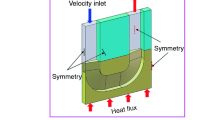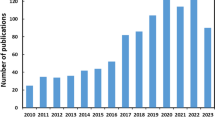Abstract
As per the available literature, most of the techniques used for boiling surface modification utilize high operational temperature and longer production duration, ensuing in higher energy utilization with more safety worries for large scale of manufacturing. Again, the important criterion for boiling surfaces is to control the porous layer (porosity) to achieve high rate of cooling. Considering these aspects, a nature-inspired and simple technique for surface modification is proposed in the present work, which is single-step forced convection electrochemical deposition followed by single-step sintering. In this technique, the surface properties can be easily managed. Using this technique, the nanocomposite coatings of higher thermal conductive Cu–TiO2 (~ 300 W/mK) nanoparticles are fabricated on copper heating surface. The growth in nanograins is occurred during sintering process, which enhances the connectivity between the deposited nanograins. The porosity, thickness of porous layer, roughness, and wettability of the electrodeposited structured surfaces are raised with amplified current supply up to 75%, 42 µm, 1.32 µm, and 38°, respectively. The heat transfer performances of these developed surfaces are analyzed through flow boiling experiments. The maximum enhancement in critical heat flux (~ 143%) and heat transfer coefficient (~ 153%) is attained on developed coated surface at lower mass flux. These augmentations are attributed to better surface wettability and better surface morphological characteristics of the developed surfaces, which are due to the existence of sufficient liquid microlayer on them. The proposed electrodeposition technique can be employed for practical cooling applications where effective handling of high rate of heat flux is a challenge.



















Similar content being viewed by others
Abbreviations
- A s :
-
Cross-sectional area of heating surface, m2
- h :
-
Heat transfer coefficient, W/m2K
- I :
-
Current, A
- k :
-
Thermal conductivity, W/mK
- Q :
-
Supplied heat to the copper block, W
- q :
-
Heat flux, W/cm2
- T o :
-
Outlet working fluid temperature, K
- T i :
-
Inlet fluid temperature, K
- T w :
-
Wall surface temperature of copper block, K
- T m :
-
Mean wall surface temperature of copper block, K
- ΔT :
-
Wall superheat temperature, K
- V :
-
Voltage, V
- x :
-
Distance between two thermocouples positions, m
References
Shojaeian, M.; Kosar, A.: Pool boiling and flow boiling on micro- and nanostructured surfaces. Exp. Thermal Fluid Sci. 63, 45–73 (2015)
Xu, O.P.; Li, Q.; Xuan, Y.: Enhanced boiling heat transfer on composite porous surface. Int. J. Heat Mass Transf. 80, 107–114 (2015)
Barber, J.; Brutin, D.; Tadrist, L.: A review on boiling heat transfer enhancement with nanofluids. Nanoscale Res. Lett. 6(280), 1–16 (2011)
Sharma, P.O.; Barewar, S.D.; Chougule, S.S.: Experimental investigation of heat transfer enhancement in pool boiling using novel Ag/ZnO hybrid nanofluids. J. Therm. Anal. Calorim. (2020). https://doi.org/10.1007/s10973-020-09922-2
Hae Min Park: Yong Hoon Jeong, Flow boiling CHF enhancement by wettability and flow conditions in a slug flow in the rectangular curved channel. Exp. Thermal Fluid Sci. 91, 388–398 (2018)
Gouda, R.K.; Pathak, M.; Khan, M.K.: Pool boiling heat transfer enhancement with segmented finned microchannels structured surface. Int. J. Heat Mass Transf. 127, 39–50 (2018)
Wang, Y.-Q.; Luo, J.-L.; Heng, Yi.; Mo, D.-C.; Lyu, S.-S.: Wettability modification to further enhance the pool boiling performance of the micro nano bi-porous copper surface structure. Int. J. Heat Mass Transf. 119, 333–342 (2018)
Sarangi, S.; Weibel, J.A.; Garimella, S.V.: Effect of particle size on surface-coating enhancement of pool boiling heat transfer. Int. J. Heat Mass Transf. 81, 103–113 (2015)
Arenales, M.R.M.; Kumar, S.C.S.; Kuo, L.-S.: P-HChen, Surface roughness variation effects on copper tubes in pool boiling of water. Int. J. Heat Mass Transf. 151, 119399 (2020)
Yu, Q.; Ma, X.; Wang, M.; Yu, C.; Bai, T.: Influence of embedded particles on microstructure, corrosion resistance and thermal conductivity of CuO/SiO2 and NiO/SiO2 nanocomposite coatings. Appl. Surf. Sci. 254(16), 5089–5094 (2008)
Akarapu, A.: Surface Property Modification of Copper by Nanocomposite Coating. National Institute of Technology, Rourkela (2011)
Gan, Y.; Lee, D.; Chen, X.; Kysar, J.W.: Structure and properties of electrocodeposited Cu-Al2O3 nanocomposite thin films. J. Eng. Mater. Technol. 127(4), 451–456 (2005)
Bund, A.; Thiemig, D.: Influence of bath composition and pH on the electrocodeposition of alumina nanoparticles and nickel. Surf. Coat. Technol. 201(16–17), 7092–7099 (2007)
Allahkaram, S.R.; Golroh, S.; Mohammadalipour, M.: Properties of Al2O3 nanoparticle reinforced copper matrix composite coatings prepared by pulse and direct current electroplating. Mater. Des. 32(8–9), 4478–4484 (2011)
Chen, R.; Lu, M.-C.; Srinivasan, V.; Wang, Z.; Cho, H.H.; Majumdar, A.: Nanowires for enhanced boiling heat transfer. Nano Lett. 9(2), 548–553 (2009)
Morshed, A.K.M.M.; Yang, F.; Yakut Ali, M.; Khan, J.A.; Li, C.: Enhanced flow boiling in a microchannel with integration of nanowires. Appl. Therm. Eng. 32(2012), 68–75 (2012)
Dixit, P.; Lin, N.; Miao, J.; Wong, W.K.; Choon, T.K.: Silicon nanopillars based 3D stacked microchannel heat sinks concept for enhanced heat dissipation applications in MEMS packaging. Sens. Actuators A 141(2), 685–694 (2008)
Khanikar, V.; Mudawar, I.; Fisher, T.: Effects of carbon nanotube coating on flow boiling in a micro-channel. Int. J. Heat Mass Transf. 52(15–16), 3805–3817 (2009)
Li, C.; Wang, Z.; Wang, P.-I.; Peles, Y.; Koratkar, N.; Peterson, G.P.: Nanostructured copper interfaces for enhanced boiling. Small 4(8), 1084–1088 (2008)
Chang, J.Y.; You, S.M.: Enhanced boiling heat transfer from micro-porous surfaces:effect of a coating composition and method. Int. J. Heat Mass Transf. 40, 4449–4460 (1997)
Yang, C.Y.; Liu, C.F.: Effect of coating layer for boiling heat transfer on micro porous coated surface in confined and unconfined spaces. Exp. Therm. Fluid Sci. 47, 40–47 (2013)
Suganthi, K.S.; Vinodhan, V.L.; Rajan, K.S.: Heat transfer performance and transport properties of ZnO–ethylene glycol and ZnO–ethylene glycol–water nanofluid coolants. Appl. Energy 135, 548–559 (2014)
Vemuri, S.; Kim, K.J.: Pool boiling of saturated FC-72 on nano-porous surface. Int. Commun. Heat Mass Transf. 32, 27–31 (2005)
Wu, W.; Bostanci, H.; Chow, L.C.; Hong, Y.; Su, M.; Kizito, J.P.: Nucleate boiling heat transfer enhancement for water and FC-72 on titanium oxide and silicon oxide surfaces. Int. J. Heat Mass Transf. 53, 1773–1777 (2010)
Forrest, E.; Williamson, E.; Buongiorno, J.; Hu, L.W.; Rubner, M.; Cohen, R.: Augmentation of nucleate boiling heat transfer and critical heat flux using nanoparticle thin-film coatings. Int. J. Heat Mass Transf. 53, 58–67 (2010)
Jo, H.; Kim, S.; Kim, H.; Kim, J.; Kim, M.H.: Nucleate boiling performance on nano/ microstructures with different wetting surfaces. Nanoscale Res. Lett. 7, 1–9 (2012)
Im, Y.; Dietz, C.; Lee, S.S.; Joshi, Y.: Flower-like CuO nanostructures for enhanced boiling. Nanosc. Microsc. Therm. 16, 145–153 (2012)
Das, S.; Kumar, D.S.; Bhaumik, S.: Experimental study of nucleate pool boiling heat transfer of water on silicon oxide nanoparticle coated copper heating surface. Appl. Therm. Eng. 96, 555–567 (2016)
Karunagaran, B.; Rajendra Kumar, R.T.; Kumar, V.S.; Mangalaraj, D.; Narayandass, S.K.; Rao, G.M.: Structural characterization of DC magnetronsputtered TiO2 thin films using XRD and Raman scattering studies. Mater. Sci. Semicond. Process. 6, 547–550 (2003)
Bera, A.; Thapa, R.; Chattopadhyay, K.K.; Saha, B.: In plane conducting channel at the interface of CdO–ZnO isotype thin film heterostructure. J. Alloys Comp. 632, 343–347 (2015)
Saha, B.; Das, N.S.; Chattopadhyay, K.K.: Combined effect of oxygen deficient point defects and Ni doping in radio frequency magnetron sputtering deposited ZnO thin films. Thin Solid Films 562, 37–42 (2014)
Patil, C.M.; Santhanam, K.S.V.; Kandlikar, S.G.: Development of a two-step electrodeposition process for enhancing pool boiling. Int. J. Heat Mass Transf. 79, 989–1001 (2014)
Kadam, A.N.; Dhabbe, R.S.; Kokate, M.R.; Gaikwad, Y.B.; Garadkar, K.M.: Preparation of N doped TiO2 via microwave-assisted method and its photocatalytic activity for degradation of Malathion. Spectrochim. Acta Part A 133, 669–676 (2014)
Ishii, A.; Nakamura, Y.; Oikawa, I.; Kamegawa, A.; Takamura, H.: Low-temperature preparation of high-n TiO2 thin film on glass by pulsed laser deposition. Appl. Surf. Sci. 347, 528–534 (2015)
Sujith Kumar, C.S.; Suresh, S.; Yang, Q.; Aneesh, C.R.: An experimental investigation on flow boiling heat transfer enhancement using spray pyrolysed alumina porous coatings. Appl. Therm. Eng. 71, 508–518 (2014)
Shin, H.C.; Dong, J.; Liu, M.: Nanoporous structures prepared by an electrochemical deposition process. Adv. Mater. 15, 1610–1614 (2003)
Kim, J. H.: Enhancement of pool boiling heat transfer using thermally conductive microporous coating techniques (Ph.D. thesis), University of Texas at Arlington, TX, USA (2006)
Moffat, R.J.: Describing the uncertainties in experimental results. Exp. Therm. Fluid Sci. 1, 3–17 (1988). https://doi.org/10.1016/0894-1777(88)90043-X
Nikolic, N.D.: Fundamental aspects of copper electrodeposition in the hydrogen co-deposition range. Zastita Materijala 51, 1970203 (2010)
Wang, Y.; Sefiance, K.: Effects of heat flux, vapour quality, channel hydraulic diameter on flow boiling heat transfer in variable aspect ratio micro-channels using transparent heating. Int. J. Heat Mass Transf. 55, 2235–2243 (2012)
Gupta, S.K.; Misra, R.D.: An experimental investigation on flow boiling heat transfer enhancement using Cu-TiO2 nanocomposite coating on copper substrate. Exp. Therm. Fluid Sci. 98, 406–419 (2018)
Morshed, A.K.M.M.; Paul, T.C.; Khan, J.: Effect of Cu-Al2O3 nanocomposite coating on flow boiling performance of a microchannel. Appl. Therm. Eng. 51, 1135–1143 (2013)
Lenz, P.; Lipowsky, R.: Morphological transitions of wetting layers on structured surfaces. Phys. Rev. Lett. 80, 1920–1923 (1998)
Young Lee, C.; Hossain Bhuiya, M.M.; Kim, K.J.: Pool boiling heat transfer with nano-porous surface. Int. J. Heat Mass Transf. 53, 4274–4279 (2010)
Zhang, B.J.; Kim, K.J.; Yoon, H.: Enhanced heat transfer performance of alumina sponge-like nano-porous structures through surface wettability control in nucleate pool boiling. Int. J. Heat Mass Transf. 55, 7487–7498 (2012)
Lee, C.Y.; Zhang, B.J.; Kim, K.J.: Influence of heated surfaces and fluids on pool boiling heat transfer. Exp. Therm. Fluid Sci. 59, 15–23 (2014)
Kandlikar, S.: A theoretical Model to predict pool boiling CHF incorporating effects of contact angle and orientation. J. Heat Transfer 123, 1071–1079 (2002)
Hegde, R.N.; Rao, S.S.; Reddy, R.: Experimental investigations of pool boiling heat transfer characteristics on a vertical surface using CuO nanoparticles in distilled water. Heat Transf Eng 35, 14–15 (2014). https://doi.org/10.1080/01457632.2013.876820
Sarafraz, M.M.; Hormozi, F.: Experimental investigation on the pool boiling heat transfer to aqueous multi-walled carbon nanotube nanofluids on the micro-finned surfaces. Int. J. Therm. Sci. 100, 255–266 (2016)
Author information
Authors and Affiliations
Corresponding author
Ethics declarations
Conflict of interest
There is no conflict of interest to declare.
Rights and permissions
About this article
Cite this article
Gupta, S.K., Misra, R.D. Flow Boiling Performance Analysis of Copper–Titanium Oxide Micro-/Nanostructured Surfaces Developed by Single-Step Forced Convection Electrodeposition Technique. Arab J Sci Eng 46, 12029–12044 (2021). https://doi.org/10.1007/s13369-021-05850-x
Received:
Accepted:
Published:
Issue Date:
DOI: https://doi.org/10.1007/s13369-021-05850-x




